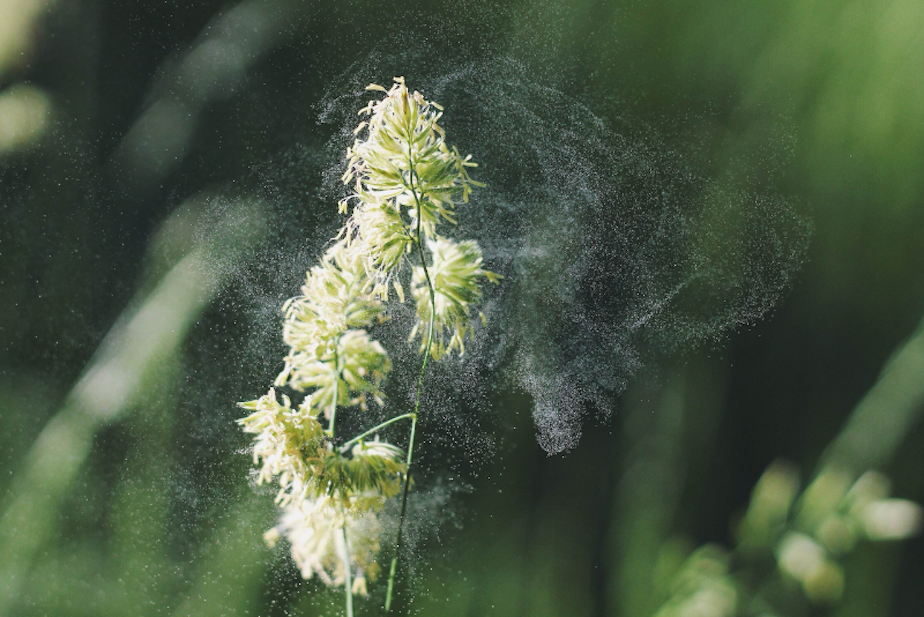Bless you! NW allergies and climate change: Today So Far

- Allergies are expected to get more severe in the years ahead as climate change progresses and gives more time for pollen to spread.
- Also, the much-needed battery industry will soon have a Washington-powered boost thanks to a new operation in Moses Lake.
This post originally appeared in KUOW's Today So Far newsletter for May 5, 2022.
By now we've all had that moment in public. Maybe it was you, or the person next to you, who could not keep in a pesky sneeze.
Achoo!
Then there is that moment, a look, a calm collected manner as if to say: "It's cool. It's just allergies."
And judging from the pollen caked on my windshield these days, there are a lot of sneezes happening out there. As KUOW's Soundside points out, allergies are expected to get more severe in the years ahead as climate change progresses. In short: warmer temps, for longer periods, will give pollen a greater share of the year to spread. Start stocking up on the allergy pills.
"And depending on the pollen types, sometimes we're getting an increase in the pollen magnitude over the season too, and all that contributes to worse allergy symptoms," said Fiona Lo, a researcher at the University of Washington's Department of Environmental & Occupational Health.
Sponsored
On top of that, changing conditions could bring new weeds to our region, like ragweed. It adds up to a more severe allergy season for the Northwest.
"So if we have a longer season, people will have a longer duration of symptoms. And if you have a higher concentration of pollen, you have not only more severe symptoms, but probably more people who will get symptoms."
Read the full story here.
The much-needed battery industry will soon have a Washington-powered boost thanks to a new operation in Moses Lake. Sila Nanotechnologies, based in San Francisco, just bought up a large, vacant factory in Moses Lake to produce components for EV batteries. Specifically, they produce anodes. For the non-techy, they're important parts for batteries. The company already has a relationship with BMW and Mercedes, which comes with a goal of increasing energy density in EV batteries. It will also produce parts for mobile phone batteries and more. Sila expects to produce enough materials to power 100,000 to 500,000 electric cars annually, and 500 million mobile phones. And it expects to expand that production.
Beyond the news and the press statements is this: jobs and a green industry. Factories like this are apt to spur a lot of jobs around our state. It's an opportune time for it to happen, too.
Sponsored
Consider how gasoline technology became so popular. We had earlier forms of battery technology more than 100 years ago, but gas-powered cars and generators triumphed because they had a greater impact on the market. Factories like this, on U.S. soil, have the potential to make a modern impact and in turn chart a course into the future of energy. There are a lot of studies and reports on this, and they all say the same thing — battery tech will be a big deal in the years ahead. For example, in 2020, the global market for new battery technology was about $92 billion. That is expected to boom to $152.3 billion by 2025.
Read more here.
AS SEEN ON KUOW

Jackie Jacobs holds her head in her hands before the start of an abortion rights rally and press conference on Tuesday, May 3, 2022 at Seattle's Kerry Park. The gathering formed the day after a draft opinion of a U.S. Supreme Court was leaked, indicating that the court intends to overturn the landmark case, Roe v. Wade. (Megan Farmer / KUOW)
Sponsored
DID YOU KNOW?
It might look like a cute, colorful star to land dwellers. But under the ocean waters, the sunflower sea star is a predator. It hunts seas urchins, clams, snails, and even small invertebrates. They are known to get more than 3 feet wide with as many as 24 limbs. And they’re mostly native to our corner of the Pacific coast (California through Alaska). Their main enemy in the water is the king crab. But even when they get in a scrape, they can ditch a limb and grow it back within a few weeks.
But as tough as this star is, it hasn’t been able to fend off a mysterious wasting disease amid higher sea temperatures. Over the past few years, the sunflower sea star population has rapidly declined. Between California and Washington state, its population has declined between 80-100%. That has led recent efforts to add the sunflower sea star to the list of endangered species.
ALSO ON OUR MINDS

Sponsored
What Europe's ban of Russian oil could mean for energy markets – and your gas prices
Crude prices will likely go even higher still after already surging following Russia's invasion of Ukraine. Crude prices jumped on Wednesday after the European Union proposed a ban on oil imports from Russia as part of a new round of sanctions targeting the country after its invasion of Ukraine.

